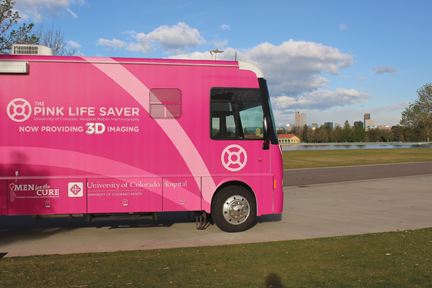
The University of Colorado Hospital's Pink Life Saver.
With the addition of its third 3D mammography system in early 2014, the University of Colorado Hospital established 3D as the standard of care in its breast imaging department. Located in Aurora, Colo., the hospital currently provides mammograms in two centers in the Denver area, and on its “Pink Lifesaver” mammography coach, which covers surrounding communities. The transition to 3D got a jump-start from fundraising efforts by the hospital’s “Men for the Cure” foundation, with donations from the group used to purchase the first 3D system and the mobile coach.
Six years ago, when Dana Knapp, BS, RTRM, CRA, joined the hospital as manager of its breast imaging department, they had just updated to digital mammography, but Knapp had seen demonstrations of 3D and knew it was the direction in which the department needed to move. “3D mammography was my mission,” stated Knapp. “It wasn’t hard to get the radiologists to buy in; and, I started working with the administration as soon as I arrived at the hospital.”
“When the hospital administration saw the images, heard about patient outcomes and looked at the statistics, our CEO and capital committee decided we needed 3D mammography for our patients,” stated Knapp.
“The radiologists, oncologists and the entire staff at the hospital always look for the latest technology that can improve outcomes,” added Wei-Shin Wang, M.D., section chief of the Breast Imaging Department.
Men for the Cure Supports the Cause and the Technology
Men for the Cure is a unique fundraising organization started by the husband of a breast cancer patient. It began nearly 15 years ago as a men’s-only dinner event to raise funds for breast cancer clinical care and research in honor of Diane O’Connor Thompson. Approximately 700 men, business owners and sports figures from the greater Denver area, attend the event each year, and to date they have raised more than $1.5 million for the University of Colorado Hospital.
“The first year we thought we could raise $15-20,000; after expenses, we netted $126,000,” explained Jeff Thompson, a founder of Men for the Cure. “We helped fund the Pink Lifesaver mobile mammography unit, and we’re really proud of that. It has been a wonderful way to turn what for me and my then 2-year-old son was sadly tragic into something very positive. I keep telling people I don’t want my son to ever worry about losing a wife to breast cancer.”
Mobile Coach Increases Compliance
The investment in the mobile coach has been a godsend for many women in the community. Despite having state-of-the-art technology and two imaging locations, the hospital found many women weren’t scheduling annual mammograms because of time and convenience. So, they put the Pink Lifesaver on the road to bring screening to women where they live and work. Five days a week, 12 months a year, the Pink Lifesaver mobile mammography coach travels throughout the greater Denver area.
The hospital launched the mobile coach a little over a year ago with a 2D system and transitioned to 3D mammography in April 2014. “We’re really excited to see what happens with the new 3D system,” said Knapp. “Everybody is hearing that we have 3D on the mobile coach, and they’ve been calling to book appointments. Our appointments are booked out for two months.”
The mobile coach stops at the hospital’s five neighborhood clinics, as well as corporations, community events and retirement homes.
“We often find people know somebody who had breast cancer. We have men come on the coach who have lost their wives to breast cancer, and they thank us for being there,” continued Knapp.
Patients Attracted to Higher Standard of Care
The hospital has also seen some economic benefits from their investment in 3D mammography. “We’ve seen about a 10 percent increase in volume since we installed our first 3D mammography system,” stated Knapp. “I attribute the increase to the fact we are the only hospital in Colorado that has made 3D the standard of care in all our sites. Women do have access to other facilities in our region for mammography, but they come to our imaging department because we offer the 3D exam to everyone.”
The hospital added a fourth 3D unit this spring and expect to perform 16,000 mammograms in 2014.
Putting Patients First
All other considerations aside, the hospital staff members consider 3D mammography the best technology for their patients and are pleased they have been able to make it their standard of care.
“The very first cancer we found with 3D two years ago was not visible on the 2D images,” noted Wang. “Last year, 13 of the 66 cancers we found were seen only on the 3D images. Those were 13 additional cancers we would not have found if we didn’t have the 3D technology.” Wang also noted he is not calling back as many patients. “Over the past year, the recall rate has gone from 12 percent to between 5 and 7 percent,” added Knapp.
“From this point forward anything we do will be 3D,” concluded Knapp. “I have a wonderful staff of technologists, and they like the fact that what they’re doing with 3D has an even greater impact on patients.”
Case study supplied by Hologic Inc.
The views and opinions expressed herein are those of the University of Colorado Hospital and are not necessarily those of Hologic. This information is intended for medical professionals in the U.S. and other markets and is not intended as a product solicitation or promotion where such activities are prohibited. Because Hologic materials are distributed through websites, eBroadcasts and trade shows, it is not always possible to control where such materials appear. For specific information on what products are available for sale in a particular country, please contact your local Hologic representative or write to [email protected].
Hologic is a trademark and/or registered trademark of Hologic and/or its subsidiaries in the U.S. and/or other countries.


 December 17, 2025
December 17, 2025 








